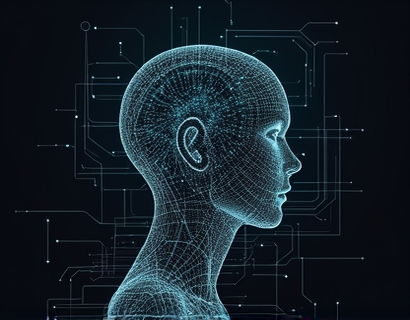Maximize Business Intelligence: Harnessing AI and Blockchain for Secure and Insightful User Analytics
In the digital age, businesses are increasingly reliant on user analytics to understand customer behavior, enhance user engagement, and make strategic decisions. The integration of advanced Artificial Intelligence (AI) and blockchain technology offers a transformative approach to user tracking and analytics, providing deep insights while ensuring security and transparency. This article delves into how leveraging AI and blockchain can maximize business intelligence, offering a comprehensive solution for modern enterprises.
Understanding the Importance of Advanced Analytics
Advanced analytics is crucial for businesses aiming to stay competitive in a rapidly evolving market. Traditional analytics methods often fall short in providing the depth and accuracy required to drive meaningful insights. AI and blockchain technology address these limitations by offering sophisticated data processing capabilities and immutable record-keeping, respectively. By combining these technologies, businesses can achieve a new level of insight into user behavior, leading to enhanced engagement and informed decision-making.
AI in User Analytics: Enhancing Insights and Efficiency
AI plays a pivotal role in modern user analytics by enabling the processing and analysis of vast amounts of data in real-time. Machine learning algorithms can identify patterns and trends that are not immediately apparent through conventional methods. This capability allows businesses to gain a deeper understanding of user preferences, behaviors, and interactions with digital platforms. AI-driven analytics can predict future trends, personalize user experiences, and optimize content delivery, all of which contribute to higher engagement rates and customer satisfaction.
One of the key advantages of AI in user analytics is its ability to automate routine tasks, freeing up human analysts to focus on more strategic activities. For instance, AI can automatically segment user groups based on behavior, sentiment, and demographic data, providing tailored insights for targeted marketing campaigns. Additionally, AI can continuously learn and adapt, improving the accuracy and relevance of analytics over time. This dynamic approach ensures that businesses remain agile and responsive to changing market conditions.
Blockchain in User Analytics: Ensuring Security and Transparency
Blockchain technology brings a unique set of benefits to user analytics, primarily through its inherent properties of security, transparency, and immutability. In a landscape where data breaches and privacy concerns are rampant, blockchain offers a robust framework for protecting user data. By storing analytics data on a decentralized ledger, businesses can ensure that user information is secure from unauthorized access and tampering.
Transparency is another significant advantage of blockchain in analytics. Every data transaction is recorded and timestamped, creating an auditable trail that can be verified by all stakeholders. This level of transparency builds trust between businesses and their users, as users can see how their data is being used and who has access to it. Moreover, blockchain can facilitate compliance with data protection regulations such as GDPR, by providing clear and enforceable mechanisms for data management and user consent.
Integrating AI and Blockchain for Comprehensive Analytics Solutions
The true power of AI and blockchain is realized when they are integrated into a cohesive analytics platform. Such a platform can leverage the strengths of both technologies to provide a comprehensive solution for user tracking and analytics. For example, AI can process and analyze data in real-time, while blockchain ensures that the data is secure and tamper-proof. This synergy enables businesses to gain actionable insights while maintaining the highest standards of data integrity and user privacy.
One practical application of this integration is in the creation of decentralized analytics networks. These networks allow multiple parties to collaborate on data analysis without compromising individual data ownership. Each participant can contribute data and insights, which are then processed by AI algorithms to generate collective intelligence. This collaborative approach not only enhances the quality and quantity of data available but also fosters a community-driven ecosystem that benefits all participants.
Case Studies and Real-World Applications
Several businesses have successfully implemented AI and blockchain-based analytics solutions, achieving significant improvements in user engagement and operational efficiency. For instance, a leading e-commerce platform integrated AI-driven analytics with a blockchain-based data storage system to enhance customer personalization and secure user data. The result was a 30% increase in customer retention and a marked improvement in user satisfaction scores.
Another example is a financial services company that used AI to analyze transaction patterns and detect fraudulent activities in real-time. By storing the analytics data on a blockchain, the company ensured that all transactions were immutable and transparent, reducing the risk of data manipulation and increasing regulatory compliance. This approach not only improved fraud detection but also built trust with customers who valued the enhanced security measures.
Challenges and Considerations
While the integration of AI and blockchain in user analytics offers numerous benefits, there are also challenges and considerations that businesses must address. One of the primary challenges is the technical complexity involved in implementing these advanced technologies. Businesses need to invest in skilled personnel or partner with technology providers who can navigate the intricacies of AI and blockchain integration.
Another consideration is the cost associated with adopting these technologies. Initial setup and maintenance costs can be substantial, particularly for smaller businesses. However, the long-term benefits in terms of improved analytics, enhanced security, and increased customer trust often justify the investment. It is essential for businesses to conduct a thorough cost-benefit analysis before embarking on this journey.
Future Trends and Innovations
The intersection of AI and blockchain in user analytics is an evolving field with exciting future prospects. One emerging trend is the development of more sophisticated AI models that can work directly on blockchain data without the need for extensive preprocessing. This advancement could further enhance the efficiency and accuracy of analytics, making it more accessible to a broader range of businesses.
Another area of innovation is the integration of AI with other emerging technologies such as the Internet of Things (IoT) and 5G networks. These combinations can lead to real-time, granular analytics that capture user behavior across multiple devices and environments, providing an even more comprehensive view of customer interactions. As these technologies continue to mature, businesses can expect even more powerful and versatile analytics tools at their disposal.
Conclusion
In conclusion, the integration of AI and blockchain technology represents a significant leap forward in business intelligence and user analytics. By harnessing the power of AI for deep insights and blockchain for secure, transparent data management, businesses can unlock new levels of engagement and strategic decision-making. While there are challenges to overcome, the potential benefits make this approach a compelling choice for forward-thinking enterprises. As the technology continues to evolve, the possibilities for enhancing business intelligence through AI and blockchain will only grow more exciting.




































